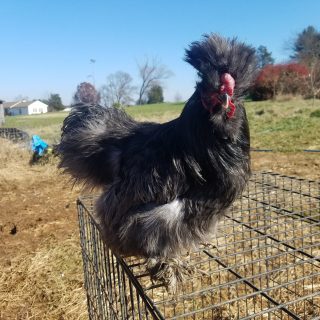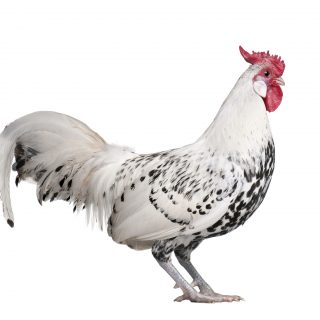New Hampshire chickens are a great choice for new chicken keepers as they are a hardy, easy to care for chicken breed. They are easy to distinguish thanks to their red and brown coloring and will blend in well with a flock. New Hampshire chickens are also relatively easy to find as they are an all-American breed.
Their versatile status makes the New Hampshire a popular chicken that can blend in well with just about any home. This breed is perfect for meat, eggs, shows, and being a pet.
They aren’t an expensive breed of chicken either as they are easy to breed and can be found on many farms around the US. So, they make a good chicken to add to any backyard flock.
They also live for around seven years when provided with the proper care and can withstand living in most environments. Just make sure that you have prepared a proper living space for them and they will thrive.
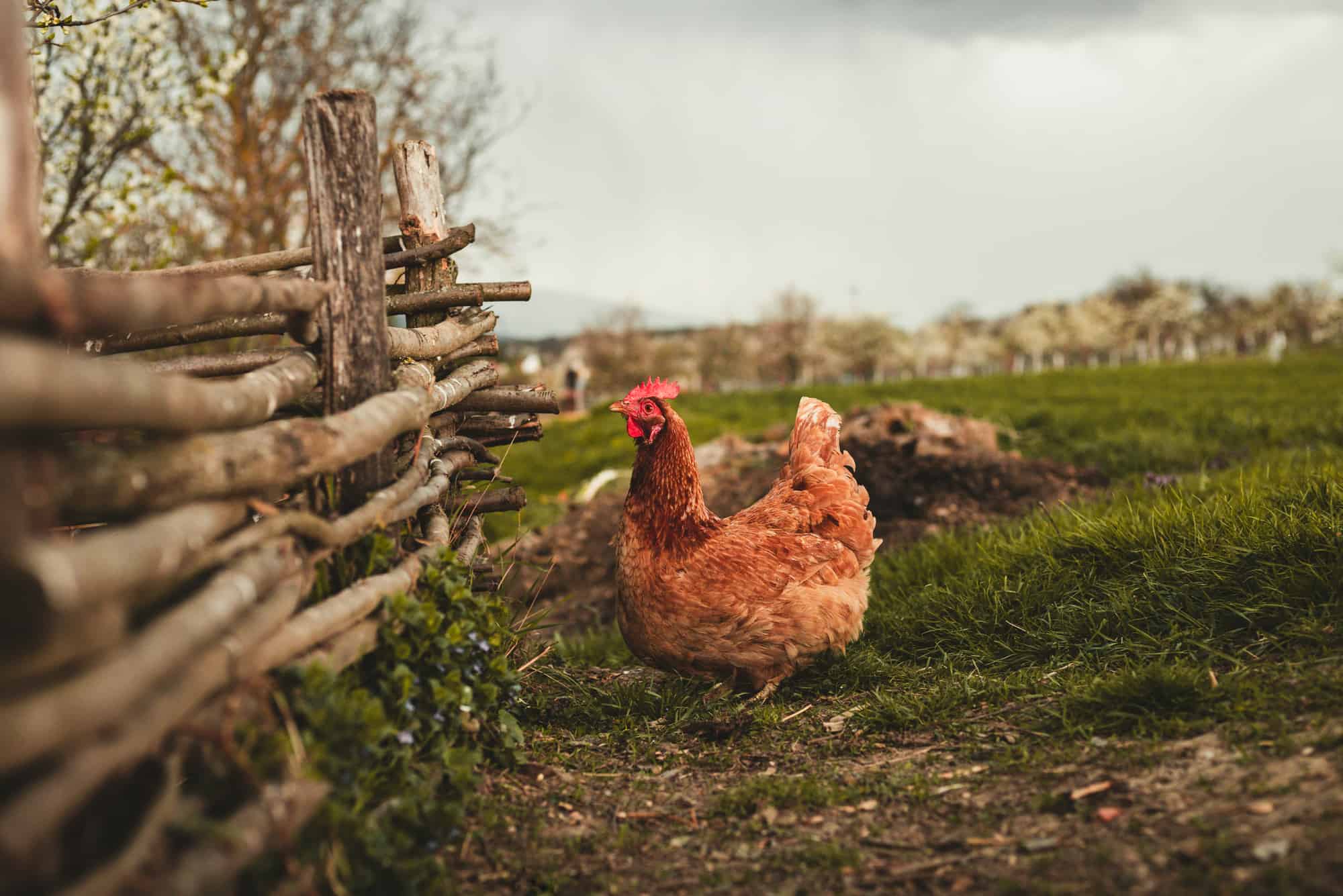
The breed lays around 200 eggs a year, making them a great source of food. How long a chicken lays eggs for will depend on their health and environment.
They can also be used for meat as they clock in around 6.5 pounds just for the hens and handling them is easy as they have a docile personality. If you are looking for a show bird, then they are a safe bet as well. They have been recognized as an official breed for quite some time.
To keep learning more about this unique breed of chicken, keep reading below.
New Hampshire Chickens
| Size | 8.5 Pounds (Rooster) 6.5 Pounds (Hen) |
| Class | SCCL (single comb clean leg) |
| Color | Red and Brown |
| Temperament | Docile |
| Hardiness | Very Hardy |
| Eggs/Yr | 200 |
| Egg Size | Large |
| Egg Color | Brown |
[ez-toc]
History & Origin
As you can likely guess from the name, these chickens were first created in the state of New Hampshire. In 1951, farmers were looking for a faster-growing chicken. By selectively breeding the Rhode Island Chicken, the New Hampshire chicken was created. The breed hit maturity incredibly fast. In fact, some New Hampshire chickens will start laying eggs for you as early as 23 weeks old.
The New Hampshire chicken was officially created in 1915, and by 1935 they were accepted into the American Standard of Perfection. The breed has since become widely spread as they are a popular choice for chicken keepers all over the US. Due to its popularity with children, it was even crowned as the official poultry bird of New Hampshire state. They have also made it overseas as Holland has now created a new blue coloring of the New Hampshire chicken.
What do they look like?
The New Hampshire chicken has a mostly reddish-brown body with dark feathers coming out of their tails, similar to a Red Ranger chicken breed. While some New Hampshire chickens may be a lighter or darker red than others, they should all have very similar coloring.
On hens, you may also notice black tips on the feathers on and near their throats. They have a single comb on top of their heads and clean legs. If you have a rooster, the comb will be standing up, but hens’ combs have a chance of laying over on their heads.
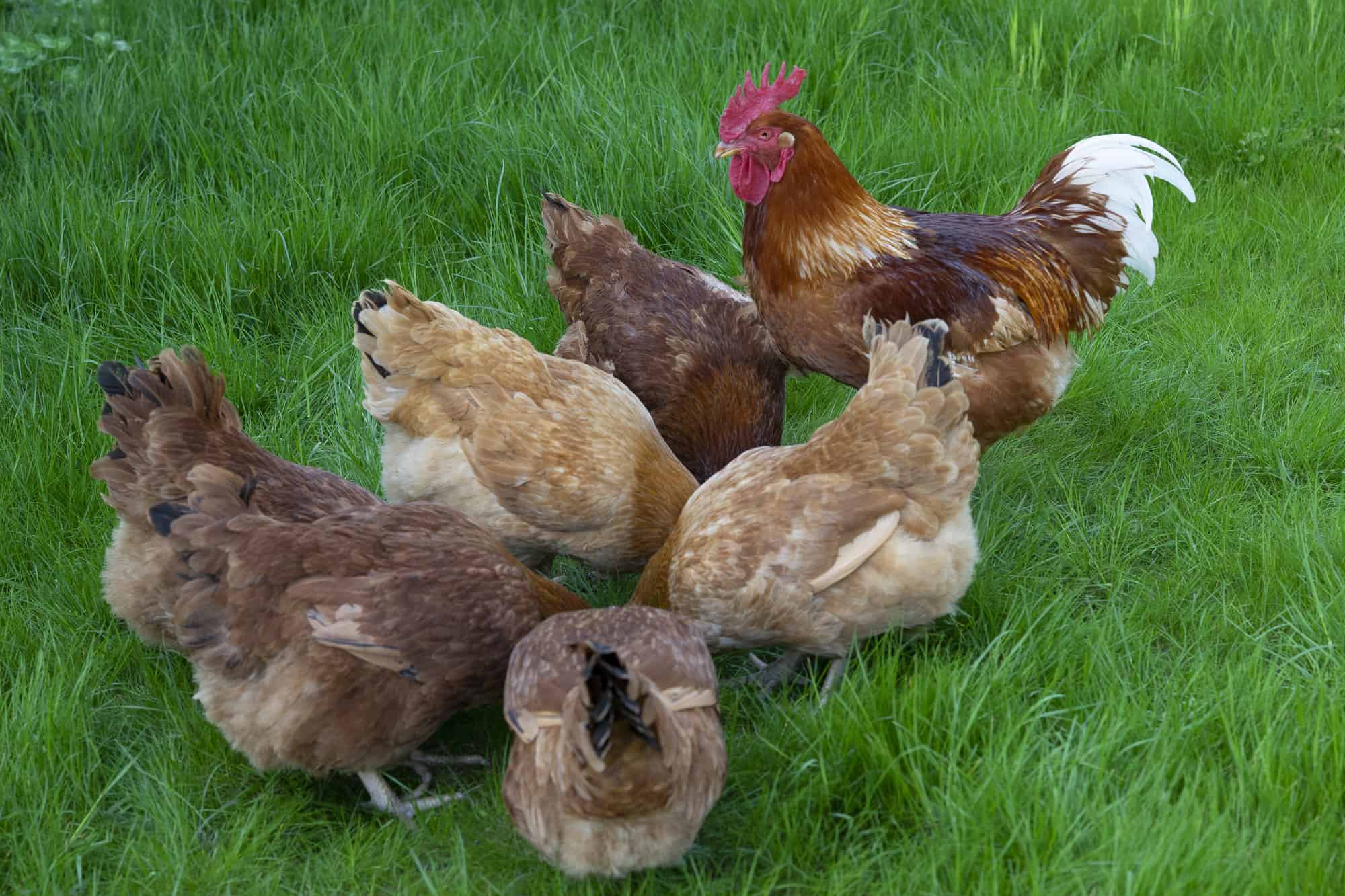
They have larger-sized bright red wattles and red earlobes to match. Their beaks have a reddish coloring to them, as do their eyes. New Hampshire chickens have a round body, and hens will weigh in at around 6.5 pounds. Roosters will weigh around 8.5 pounds, and both sexes have yellow toes. There is a Bantam version of the breed that weighs in at around 2 pounds.
You should note that leaving the breed in the sun for extended periods of time will cause their feathers to lighten. While this won’t affect the health of the bird, it could be a problem if you are planning to enter them into a show. In addition to the breed standards above, a blue version of the New Hampshire chicken exists, as does a white version.
The New Hampshire chicks are born yellow and will grow into their red coloring quickly. Depending on the chick, you may be able to see some red in their feathers when they are born. Be careful when looking at chicks, as they do look similar to the Rhode Island Red chicken. Luckily, this problem doesn’t persist into adulthood as the Rhode Island and New Hampshire chickens have some strikingly different features, such as their wattles.
Need some help keeping your chickens health and care taken care of? Check out the Organized Chicken Keeper for an easy to follow system.
Temperament
New Hampshire chickens are perfect for keeping in flocks and won’t fight among themselves. They also can get along with other breeds of chickens, as long as they aren’t aggressive. This breed also loves people and will happily interact with you whenever you cross their paths.
They love attention and when raised with handling, they won’t be mad if you pick them up or pet them. The breed can even be patient around children, but you should still be cautious as young children shouldn’t be left alone with them. They are also a quiet breed of chicken, so you won’t need to worry about them getting too chatty.
One area that things will change a bit is when there is food involved. New Hampshire chickens can be a bit food aggressive, so be especially careful when giving them feed. You will want to ensure that young children don’t feed them and check to make sure that everyone in your flock is getting the appropriate amount of food.
If you notice aggression problems among your flock, then you will need to work on establishing a new feeding strategy to keep the more dominant chickens in line.
In most flocks, a pecking order will be established early on, so as long as you are providing the proper amount of food, birds should work it out themselves. If you are mixing breeds together, then this can be a bit of a problem. There is a high chance that your New Hampshire will try to protect the food, in which case, you will need to look into providing additional feeders.
This is a breed that loves to roam, so making them free-range is quite easy. Depending on the amount of land you have, you can let them walk around your yard or build a chicken run. In fact, letting New Hampshire chickens roam around outside is usually an essential part of making them happy.
What is their purpose?
New Hampshire chickens are great for everything and considered a great dual purpose chicken. Whether you are looking for meat, eggs, shows, breeding, or even just a pet, this breed excels at each of these categories.
This breed can provide a good amount of meat, especially when it comes to the 8.5-pound roosters. While there are some larger chicken breeds you could raise out there, they may not be as good at laying as the New Hampshire.
On average, you are looking at getting around 200 eggs per year per hen. This breed grows to maturity extremely quickly and will begin laying eggs at around 23 weeks old. They have been noted to lay up to 250 eggs and having a flock will ensure that you have breakfast most every morning. The egg production may slow down in the winter, but with the right environment (warm, insulated, and draft free), this likely won’t be a problem.
This is also a common bird you can see in shows, so raising them to compete won’t be hard. They are a hardy bird, and even a first-time competitor may do well with the New Hampshire chickens. You also may find that it’s easier to get chicken care tips for this breed due to their popularity on the show floor.
When buying a New Hampshire chicken, try to gather as much information as you can on reputable breeders; a show is a great place to start. If possible, ask to see the hens and roosters the chicks are being raised from. While this isn’t a rare breed, you will still want to ensure that you’re not buying the wrong chick.
Lastly, New Hampshire chickens are broody and can provide you with a decent amount of chicks. The breed has even been known for taking other breeds’ eggs under their wings and hatching them.
If left with a rooster, you will likely have chicks within a few months, as long as the birds are being well taken care of. Just try to ensure that they are laying their eggs in the coop and not while roaming around in your yard, as this will impede hatching.
Care and Health
To begin with, you will want to set up a coop that is large enough to hold these birds. At 6.5 to 8.5 pounds, this breed will need quite a bit of room to spread their wings. Ensure that the coop you build is well-insulated to keep the cold and rain out, as with most single combs, the New Hampshire chicken won’t do well if it gets cold. They are also prone to get frostbite on their combs. So, make sure to these chickens are kept warm in the winter.
New Hampshire chickens are happiest when they are able to spend time outdoors. You will want to either build a run or chicken-proof your yard. This breed generally won’t wander too far and will stick close to their coop. You will want to be vigilant with your schedule to ensure that your flock knows what time they go out each day.
While chickens do tend to wander back into their coops in the evening. It’s important to ensure you have all your birds accounted for by nightfall as predators like foxes will be prowling around.
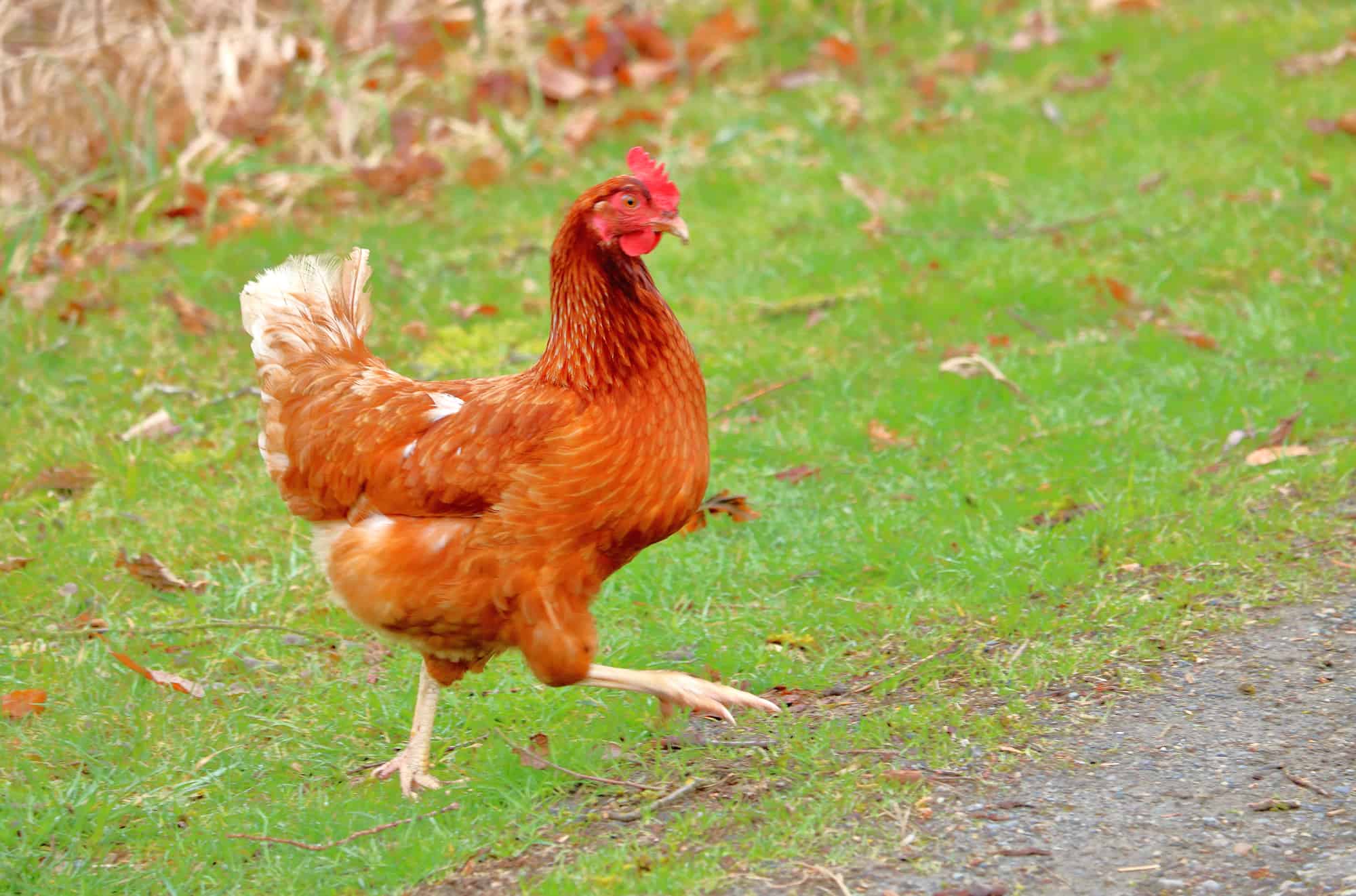
These birds do forge well when they are left to free-roam, but you should never ensure that they are finding enough food to meet their dietary needs each day. You will need to know how much feed chickens need and give it to your chickens every day to ensure they stay healthy.
As mentioned above, this breed can be food aggressive, so having multiple of the best chicken feeders and best chicken waterers you can are a great idea. If you plan to add any other chickens in make sure to know how to introduce new chickens to try and avoid fights.
The New Hampshire chicken will also require spaces where they can be in the shade during the summer.
You won’t need to worry about especially bathing this breed every week, but you should inspect your flock regularly. Parasites are a common problem in chickens, and once one bird gets a case of mites, it will quickly spread through the flock. Other than these problems, this is a hardy breed that can live in most places in the world without a problem.
FAQ
Are New Hampshire chickens good layers?
Yes, the New Hampshire chicken is a fantastic breeder that will provide you with around 200 eggs a year. On top of that, they are known for laying through the winter and will ensure you have food year-round.
Are New Hampshire Reds friendly?
These are friendly birds that love to be around people and can blend in with other peaceful breeds. While you will still want to get them used to handling when they are young, they make excellent pets.
Are New Hampshire chickens good for meat?
Yes, Hens grow up to 6.5 pounds, and roosters grow to 8.5 pounds. They both have round bodies and will provide you with a decent amount of meat.
What age do New Hampshire Reds start laying?
New Hampshire chickens can start laying as early as 23 weeks. They are a breed made to mature fast.
How long do New Hampshire Reds live?
New Hampshire chickens can live around 7 years or so. When considering how long chickens can live it depends on the level of their care and health.
What color eggs do New Hampshire Reds lay?
The New Hampshire chicken lays brown eggs.
What size eggs do New Hampshire chickens lay?
The size of the New Hampshire chickens lays large eggs.
Are New Hampshire reds quiet?
Yes, this is a quiet breed of chicken.
Are New Hampshire chickens heat tolerant and/or Cold Hardy?
While they aren’t incredibly sensitive to the cold like some breeds, they do have a single comb that is susceptible to frostbite. You will want to keep them warm in the winter.
If you need more help with taking care of your chickens, check out The Organized Chicken Keeper for a complete system for managing their health through keeping their supplies stocked and coop clean.

